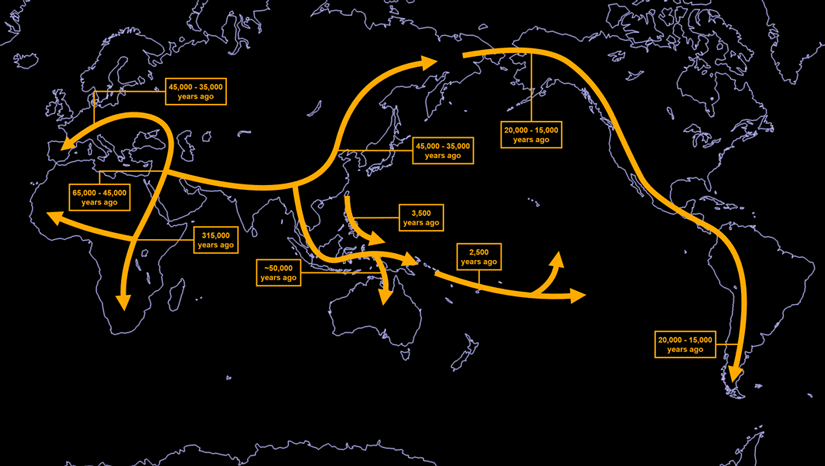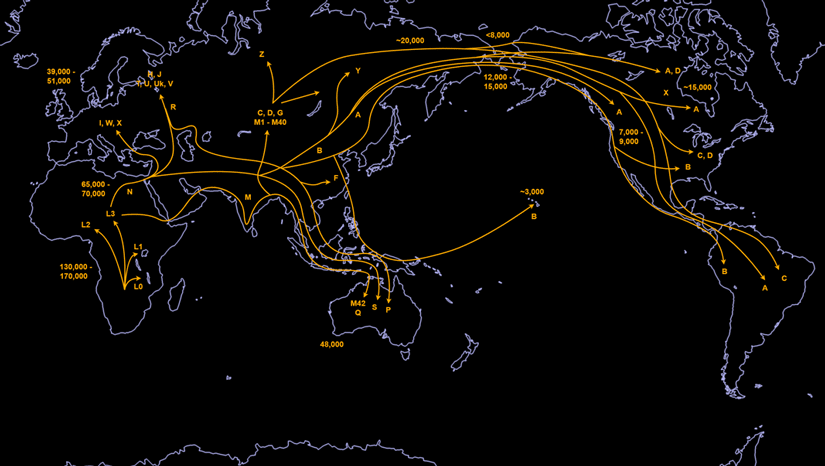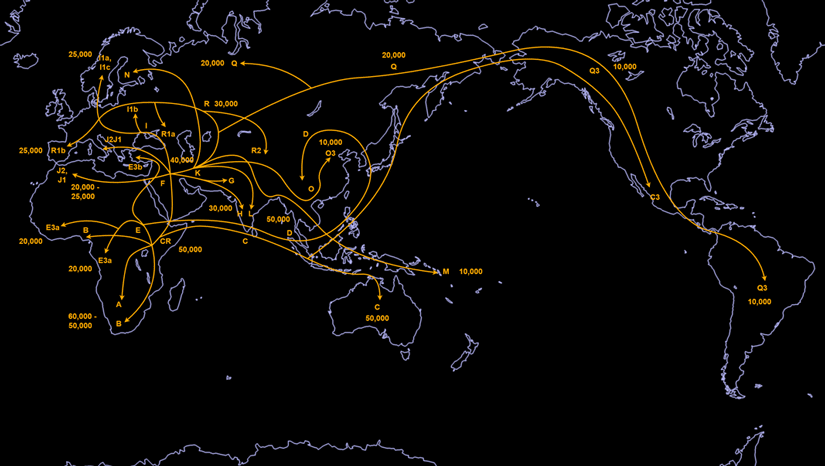Human Migration
Our species, Homo sapiens, evolved in what is now sub-Saharan Africa, by around 315,000 years ago (Xue-feng Sun, Shao-qing Wen, & Cheng-qiu Lu, 2021) from an earlier human species, possibly Homo heidelbergensis, which iteself appears to have evolved from Homo erectus (also known as Homo ergaster) (Relethford, 2008). Scientists often refer to these ancient ancestors as anatomically modern humans (Relethford, 2008). This is to distinguish them from other human species who lived around the same time. Anatomically-modern humans can be distinguished from other human species by their large brains (though the brains of Neanderthals were larger and the brains of Denisovans were likely larger as well), thin-walled, high-vaulted skulls, flat and nearly vertical foreheads with little to none of the heavy brow ridges and prognathism (protrusion of the lower jaw) seen in other species of human (Smithsonian Natural Museum of Natural History, 2021). This gave anatomically modern humans a distinct look compared to other human species.
Some of these anatomically modern humans left Africa between 65,000 and 45,000 years ago and slowly migrated to every continent on Earth (other than Antarctica) (Xue-feng Sun, Shao-qing Wen, & Cheng-qiu Lu, 2021). This migration first took them to the other parts of the Old World (the Middle East, Asia, and Europe) and later to the New World (the Americas). An approximate timeline of these migrations can be seen in Figure 5: Human Migration.

When anatomically modern humans arrived in the Middle East, Asia, and Europe they found other species of humans already living there. These human species are often referred to as archaic humans and include Neanderthals (Homo neanderthalensis) and Denisovans (Denisovans are a relatively new discovery and have no official species name yet due to the lack of a type specimen). Anatomically modern humans interbred with at least some of these species, including Neanderthals and Denisovans. Evidence of this interbreeding can be found in the nuclear DNA of present-day humans (Xue-feng Sun, Shao-qing Wen, & Cheng-qiu Lu, 2021).
People of Middle Eastern, Asian, or European descent can expect, on average, to find that between 1% and 3% of their nuclear DNA comes from Neanderthals. The percentage for people from sub-Saharan Africa is usually close to zero with any Neanderthal or Denisovan genes most likely coming from recent interbreeding with people from the Middle East, Asia, or Europe. The highest rates of Denisovan DNA can be found in people from Melanesia with between 4% and 6%, with lower amounts found in people from Southeast Asia and the Pacific Islands (MedlinePlus, 2022). Neanderthal and Denisovan DNA does not appear to be present in mitochondrial or Y-chromosomal DNA as both of these appear to have been replaced by the anatomically modern human versions through interbreeding (Gibbons, 2020).
Some genetic testing providers or genetic test analysers include in their results estimates of a person's Neanderthal DNA (see DNA Testing).

Since all present-day humans share mitochondrial and Y-chromosomal DNA from the same sub-Saharan African source these types of DNA can be used to chart human migrations across the planet by looking at genetic mutations in the mtDNA and Y-DNA of human populations. Genetic mutations arise when errors occur during the replication of DNA. By looking at the number of genetic mutations between populations we can estimate the point in time when the populations diverged from one another. This divergence is the result of the partial migration of a population from one geographic region to another (Scally & Durban, 2012). mtDNA and Y-DNA are grouped into haplogroups and Figure 6: mtDNA Migration Map and Figure 7: Y-DNA Migration Map show the estimated timelines for the evolution and distribution of mitochondrial and Y-chromosomal DNA haplogroups.

Your mtDNA haplogroup will tell you where in the world your mtDNA first arose. Your Y-DNA haplogroup (assuming you have a Y-chromosome) will tell you where in the world your Y-DNA first arose. These two pieces of information can therefore tell you something about the path that your direct maternal and direct paternal ancestors took as they moved out of or within sub-Saharan Africa. While only people with a Y-chromosome can take a Y-DNA test, a person without a Y-chromosome can have a relative with a Y-chromosome take the test for them. This relative should come from the same paternal line: their father, a brother (who shares the same father), an uncle (father's brother), their grandfather (father's father), or a cousin (father's brother's son) would be suitable.
Please note: There is much ongoing scientific debate as to when anatomically modern humans left Africa and whether they left in one wave or in multiple waves over a period of time. There is also ongoing scientific debate as to when anatomically modern humans arrived in parts of Asia and Australia. I have done my best to synthesise the currently available research into a cohesive and easily understandable narrative.
Figure References:
Figure 5: Human Migration Map - Original work created using map template from CraftMAP and information from:
National Geographic Magazine. (2013). Global Human Journey. Retrieved from National Geographic: https://education.nationalgeographic.
Xue-feng Sun, Shao-qing Wen, & Cheng-qiu Lu. (2021, February 8). Ancient DNA and multimethod dating confirm the late arrival of anatomically modern humans in southern China. PNAS, 118(8), e2019158118. doi: https://doi.org/10.1073/
Figure 6: mtDNA Migration Map - Original work created using map template from CraftMAP and information from:
Wallace, D. C. (2015). Mitochondrial DNA Variation in Human Radiation and Disease. Cell, 163(1), 33-38. doi: https://doi.org/10.1016/
Figure 7: Y-DNA Migration Map - Original work created using map template from CraftMAP and information from:
Adntro. (2020). Haplogroups: The mark of a great journey. Retrieved from Adntro: https://adntro.com/en/blog/ancestry/
References:
Gibbons, A. (2020, September 24). How Neanderthals lost their Y chromosome. Retrieved from Science: https://www.science.org/
MedlinePlus. (2022, June 23). What does it mean to have Neanderthal or Denisovan DNA? Retrieved from MedlinePlus: https://medlineplus.gov/
Relethford, J. H. (2008). Genetic evidence and the modern human origins debate. doi: https://doi.org/10.1038/
Scally, A., & Durban, R. (2012). Revising the human mutation rate: implications for understanding human evolution. Nature Reviews Genetics(13), 745-753. doi: https://doi.org/10.1038/
Smithsonian Natural Museum of Natural History. (2021, January 22). Homo sapiens. Retrieved from Smithsonian Natural Museum of Natural History: https://humanorigins.si.edu/
Xue-feng Sun, Shao-qing Wen, & Cheng-qiu Lu. (2021, February 8). Ancient DNA and multimethod dating confirm the late arrival of anatomically modern humans in southern China. PNAS, 118(8), e2019158118. doi: https://doi.org/10.1073/